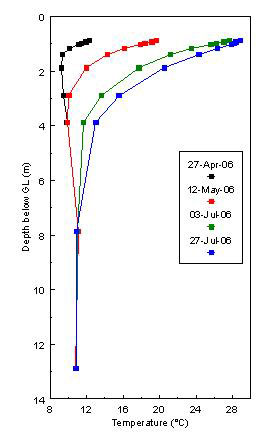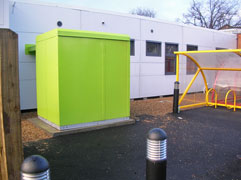Geothermal Energy & "Geothermal Heat Pumps"
"Geothermal Energy" refers to heat from the Earth. The heat from geothermal energy is normally too deep to be accessed, except where volcanic activity comes close to the surface, as in Iceland. In Iceland geothermal energy can be used directly for heating, or even for generating electricity. This form of genuine geothermal energy is sometimes referred to as "Deep Geothermal Energy".
Normally there is a much lower level of heat found at shallow depth beneath the surface of the ground – around 10°C in the UK. This energy comes from the sun and the temperature found at a depth of six metres normally reflects the Mean Annual Air Temperature found at any given location. The temperature at six meters depth will be constant all year round if left undisturbed. This temperature in the ground can be accessed by a Ground Source Heat Pump.
The term "Geothermal Heat Pump" is also used – somewhat confusingly – for marketing purposes, although none of the energy accessed originates from true "geothermal energy". On this page the term "Geothermal Heat Pump" is used to mean a "Ground Source Heat Pump". The term "Shallow Geothermal Energy" is – somewhat confusingly – used to refer to heat in the first 100 metres of depth (even though the heat present does not come from the centre of the earth).
Geothermal Heat Pump
A Geothermal Heat Pump can be an efficient means of saving money and saving carbon emissions if carefully designed for space heating of an appropriately designed building.
The first priority should be to ensure that the building is well insulated (and well managed). All new buildings should follow Part L of the Building Regulations, have high insulation built in and be well constructed to minimise heat loss through air leaks.
Because a geothermal heat pump is more efficient when producing a lot of warmth – as opposed to a small amount of heat – the distribution system in the building should match this: a large area of underfloor heating distributing warmth is more efficient than a small area of radiators emitting high temperatures (and causing draughts).
Coefficient of Performance
The key to the efficiency of a heat pump is the Coefficient of Performance: the “CoP”. In spite of the first law of thermodynamics, which tells us that energy can neither be created nor destroyed, a heat pump in a good installation can yield up to four units of heat for each unit of electricity consumed. The geothermal heat pump is not creating this energy, but merely separating a medium temperature from the ground into warmth (which can be used for heating) and cold (which can be returned to the ground).
The CoP will vary with each installation, but the lower the output temperature to the heat distribution system the higher the CoP will be. If an output temperature of 60°C is needed to heat radiators the CoP is likely to fall to level of only 2.5. If the heat distribution is to a well designed underfloor heating system that works well at an output temperature of 40°C then the CoP can rise to a level of 4.
The input temperature is also critical to the CoP of the heat pump. The higher the input temperature from the ground, the lower the amount of work needed from the heat pump, the higher the CoP will be. In fact, the critical factor is the “uplift” between the source temperature and the output temperature.

Heat moves very slowly in the ground
Normally a geothermal heat pump starts with a ground temperature of about 10°C: this is the natural temperature of the ground at a depth of six metres. This temperature of around 10°C will be found across Great Britain, summer or winter, unless unusual conditions apply. The reason is that heat only moves very slowly in the ground.
Unusual conditions will be found where a heat pump is in action: as a pump draws heat from the ground the ground temperature will fall from the natural level of 10°C to a lower level (which depends on the amount of heat drawn from the ground and the volume of ground from which it is extracted).
As the ground gets colder the pump will have more work to do to deliver the output temperature required for heating. In these conditions the CoP of the heat pump will fall below the rule of thumb figure, often given, of 4.
The CoP is critical because, although a pump can be efficient, electricity is more expensive than gas. If you do not get a high CoP from your heat pump it could be cheaper to use a gas boiler for heating. In terms of carbon saving a heat pump releases no CO2 on site, but you should consider the CO2 emitted at the power stations to create the electricity you use.
Interseasonal Heat Transfer
ICAX has introduced a radical new mechanism for collecting surplus solar heat in the summer, storing it in Thermalbanks, and releasing it via heat pumps to heat buildings in winter: Interseasonal Heat Transfer.
By using ThermalBanks for thermal energy storage ICAX enables its heat pumps to start with a ground temperature of 25°C, instead of starting with an autumn ground temperature of 10°C. This doubles the CoP of the heat pump from the standard figure of 4 up to 8 and transforms the economics, and carbon saving, of using a heat pump.
In practice the CoP of a standard heat pump across the winter season can fall from 4 to below 3 as the ground gets colder. Similarly, the seasonal CoP of an ICAX system will fall from the autumn level of 8 to 5.5 as heat is extracted from the ThermalBank. The Seasonal CoP - the "Seasonal Performance Factor" (SPF) - is more significant than the measurement of the CoP at any one time.
A standard heat pump extracts energy from a slinky pipe buried in the ground at a depth of around two metres and lowers the temperature in the ground. Eventually heat from the surrounding ground will migrate back to the “heat overdraft” created. Ultimately this energy comes from the sun.
Earth Energy Systems - EES
A ground source heat pump uses the earth as the source of heat in the winter, and as the "sink" for heat removed from the building in the summer. For this reason, ground source heat pump systems are also known as earth-energy systems (EESs).
Geothermal Heat Pump
Where land is limited a geothermal heat pump can be linked to vertical boreholes which extract heat from depths of down to 150 metres. The energy taken from these boreholes is also replenished ultimately from the sun, although the term “geothermal energy” is often used, as if the heat source were the earth's core temperature. The source of energy is still the sun, but the earth provides the valuable function of storing energy.
Borehole Thermal Energy Storage
ICAX takes advantage of these properties of the earth to store energy. ICAX collects surplus solar energy in summer and stores it in ThermalBanks in advance of the heating season. Most of the heat energy provided by Interseasonal Heat Transfer comes directly from the sun, with a little help from a heat pump.
See also: Geothermal Heating at Heathrow
See also: Seasonal Performance Factor for a discussion on SPF
See also: Renewable Heat Incentive
See also: Ground Source Energy
See also: How geothermal heat pumps work
See also: Seasonal Heat Storage
See also: Ground source heating and cooling



